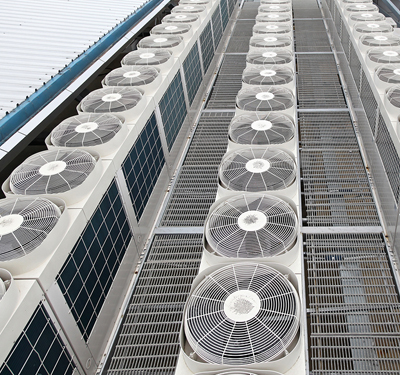

Central Air Adds LEED Points
Posted by Bob Schneider on in Energy Solutions
Developers are showing increasing interest in central air conditioning for many reasons. Ideally suited for multi-story, multi-use dense, vertical developments, central air conditioning reduces energy use by 30–50%, helps earn LEED points, eliminates rooftop condenser “farms” that preclude green roof options and become maintenance nightmares, and generates revenue.
Central air conditioning systems have smaller footprints than HVAC rooftop unit “farms.”
Each project presents its own unique situation and needs to be evaluated, however, a representative project with about 400,000 ft2 GLA illustrates the revenue potential of this cooling system approach:
Annual Income: $483,818 Annual Expense: 307,888 Annual Revenue: $175,930
In addition to revenue generation, central airconditioning benefits Landlords by presenting visually cleaner roofs, with fewer screens to consider. It also lowers reroofing costs and improves security. Tenants also enjoy these advantages through reduced issues with local authorities and lower roof and securityrelated common area costs. Tenants’ HVAC equipment is less expensive, and fitups are faster and less complicated. Onsite and Webenabled remote personnel provide quick diagnosis and handling of issues, giving Landlords greater control and Tenants fewer operational headaches and management distractions.
Sustainability
Central airconditioning offers many opportunities to obtain additional LEED points, including:
- Innovative waste water technologies
- Optimize energy performance
- Measurement and verification
- Outdoor air delivery monitoring
- Controllability of system – thermal comfort
- Thermal comfort – design
Prerequisites for earning LEED points include meeting codes for energy, ventilation, and comfort; having a non-smoking facility; and commissioning the building. A 14% overall reduction in energy usage compared to code is mandatory to qualify, and earns 2 points. Points increase with greater efficiencies, up to a maximum of 10 points for a 42% overall energy use reduction.
Central air can also help in meeting the demands of the 2030 Challenge, which is being adopted by increasing numbers of state and federal buildings. Supported by AIA, USGBC, and ASHRAE, it requires an immediate 50% reduction in fossil fuel usage in new buildings and major renovations. The reduction requirement will be 60% in 2010 and will grow in 10% increments every five years, topping off at 90% in 2025. In addition to reducing electrical usage by up to 30% compared to rooftop condenser units, the smaller footprint of a central airconditioning system frees up space for solar panels, windmills, and other green roof options.
Complexities
For all of its benefits, central airconditioning does require informed discussions with Landlords on financial aspects such as simple payback vs. life cycle cost, amortization, market level lease rates with energy costs included vs. value pricing, and life cycle averaging of
maintenance costs. With energy costs escalating faster than inflation, the cost reduction offered by central air compared to rooftop HVAC units over its 30year life is impressive. It is even more compelling when the comparison includes the whole building rather than just focusing on HVAC or even MEP costs. Additional savings are gained by smaller HVAC spaces, smaller ducts and pipes, reduced power requirements resulting reduced structure, less maintenance required (by avoiding replacement of rooftop units every five years), and lower financing costs.
Impartial third-party engineering studies and evaluations provide critical data for financial rationales and system selections.

 Previous STORY
Previous STORY